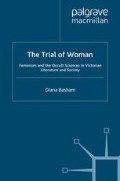Abstract
When Ada Lovelace discovered in 1843 that she had become ‘God’s Prophet’ with a mission to mesmerise the idle rich of the London salons, she was, in fact, less alone in her exceptionality than she probably suspected. For the 1840s were, among other things, the decade of female prophecy. It was during these years that women began to appear, both in Victorian literature and in Victorian society, wearing the mantle of the prophetess and claiming for themselves the articulation of an inspired discourse. As innumerable revisions of the Cassandra figure make clear, there was nothing new about the concept of the prophetess per se. What was unusual about her re-appearance at this time was that she now spoke and prophesied on behalf of her own sex, just as Princess Ida’s prophecies of social change in Tennyson’s poem of 1846 were specifically focused on her project for establishing a college for women. This phenomenon was accompanied, in the literature of the period, by another closely allied to it; recurrent scenes of rebellious outbursts on the part of previously suppressed female characters, such as Edith Dombey, in Dickens’ Dombey and Son (1848) who tersely declares, as prelude to her prophecy:
And the woman fled into the wilderness, where she hath a place prepared of God…
And there was war in heaven:
Revelations, Ch. 12, Verses 6 & 7
‘… knowledge, so my daughter held, Was all in all; they had but been, she thought, As children; they must lose the child, assume The woman: then, Sir, awful odes she wrote, Too awful, sure, for what they treated of, But all she is and does is awful; odes About this losing of the child; and rhymes And dismal lyrics, prophesying change Beyond all reason: these the women sang;’
Tennyson, The Princess (1846) 1
And in her character as a keen resenter of the wrongs of her sex, she was disposed to find a new and flagrant instance of man’s chronic injustice to woman in his assumption of the prophetic office to the almost total exclusion of her. She expressed the conviction that she herself was but one of many of her sex who had been similarly endowed, but that their male associates had generally taken all the credit to themselves;
Edward Maitland, Anna Kingsford, Her Life, Letters, Diary and Works (1896) 2
Access this chapter
Tax calculation will be finalised at checkout
Purchases are for personal use only
Preview
Unable to display preview. Download preview PDF.
Notes
Alfred Tenneyson, Poems and Plays (Oxford University Press, 1965), P. 159.
Edward Maitland, Anna Kingsford, Her Life, Letters, Diary and Works (George Redway, 1896), vol. 1, p. 190.
Charles Dickens, Dombey and Son (The Oxford Illustrated Dickens, 1950), ch. 14.
See John Killham, Tennyson and The Princess (Athlone Press, 1958), p. 33.
See Ethel Colburn Mayne, The Life of Lady Byron (Constable, 1929), p. 136.
Harriet Taylor Mill, Enfranchisement of Women (Virago Reprint, 1983), p. 42.
J. S. Mill, The Subjection of Women (Virago Reprint, 1983), pp. 105–107.
Cathrine Crowe, The Night-side of Nature (Aquarian Press Reprint, 1986), p. 64.
See Gordon Waterfield, Lucie Duff Gordon (New York: Dutton, 1937), p. 83–4.
See Charles Tennyson & Hope Dyson, The Tennyson’s Background to Genius (London: Macmillan’s, 1974), p. 165.
See Barbara Taylor, Eve and the New Jerusalem (Virago, 1983), p. 163.
Florence Nightingale, Cassandra, Published as Appendix 1, in Ray Stachey, The Cause (Virago Reprint, 1978), pp. 413–16.
Copyright information
© 1992 Diana Basham
About this chapter
Cite this chapter
Basham, D. (1992). The Prophetic Element in Nineteenth-Century Women’s Discourse. In: The Trial of Woman. Palgrave Macmillan, London. https://doi.org/10.1057/9780230374010_2
Download citation
DOI: https://doi.org/10.1057/9780230374010_2
Publisher Name: Palgrave Macmillan, London
Print ISBN: 978-1-349-38881-3
Online ISBN: 978-0-230-37401-0
eBook Packages: Palgrave Literature & Performing Arts CollectionLiterature, Cultural and Media Studies (R0)

